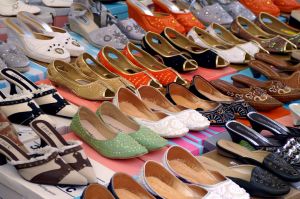Ok, if I asked you how many pairs of shoes you own, how many of you could give me an honest answer? Do you have a few select pairs that you always depend on, or do you have a mountain in your closet that you dig through everyday for the perfect pair?

Now, the harder question. Once you get that perfect pair on, are they killing your feet before the end of the day?
Yes, fashion is important. Comfort is more important. If your shoes don’t fit properly you’re costing yourself.
In the name of fashion women will commit all kinds of abuses on their feet.
On average, women squeeze their feet into shoes that are 2 1/2 sizes too small for them. They wear narrow-toed shoes that squash the tip of the foot into abnormal positions. They wear high-heels that put an unfair amount of pressure on the balls and toes instead of sharing the load evenly through the whole foot.
Women account for nearly 90% of the surgeries done for common foot disorders such as bunions, hammertoes and neuromas.
A bunion is a painful, bony lump covered by a pad of tender flesh that results from excess pressure or friction. This pressure causes the joints and bones around the big toe to be shoved out of alignment and the body reacts by trying to pad and protect the area. Bunions can run in the family, but research has shown that shoes carry the biggest blame.
Hammertoes usually accompany bunions. The condition develops when the end of a toe (usually the 2nd and 3rd) has been forced by pressure to face permanently downward, like the head of a hammer. Hammertoes can be painful and can impair the ability to walk. Thick calluses or corns also develop on the tops of these toes.
A Neuroma is swelling of a nerve in the foot. When the bones of the foot are continually squeezed together they rub and irritate the surrounding nerves. The entire lower foot may eventually become numb or develop a burning or tingling sensation.
So, here’s your assignment. Get in there and try those shoes on. If they don’t fit toss them out. I don’t care how cute they are. Well, ok, maybe I care a little. But the bottom line is: if your feet aren’t happy, neither are you.
Check your shoes for the following “fit features”:
Trace an outline of your biggest foot. Yes, most people have one foot larger than the other. Then place that same side shoe on top of this shape. If you can still see the outline you made, the shoe is too small. You want the shoe and your outline to match as closely as possible.
Don’t depend on the size, try your shoe on. Just as with clothing, shoe manufacturers all have their own ideas about sizes.
Try shoes on at the end of the day when your feet are largest.
Shoes that are too tight aren’t going to stretch.
Check for a finger-width space between your longest toe and the end of the shoe.
Make sure the ball of your foot fits comfortably into the widest part of the shoe.
Your heel should fit comfortably in the shoe with a minimum amount of slippage.
A heel less than 1 inch is best.
Avoid shoes with seams that can provide additional areas of friction.
Aim for cushioning, non-slip, and lightweight.
I know it’s hard, but trust me. Your feet will thank you for it.
Related Articles:
Foot Care – Blister Prevention
Foot Care – Calluses and Corns

